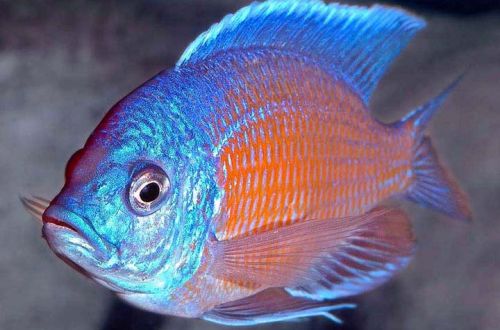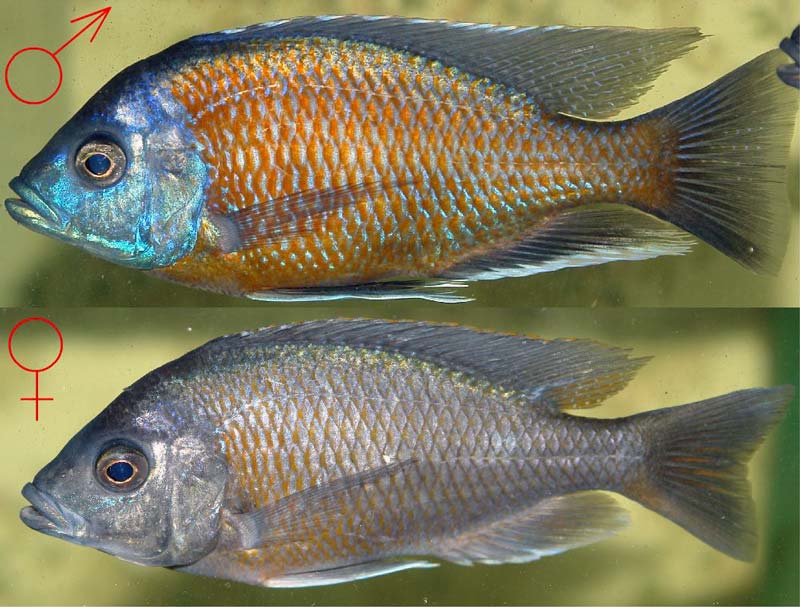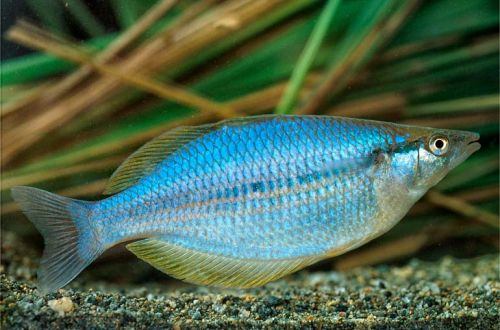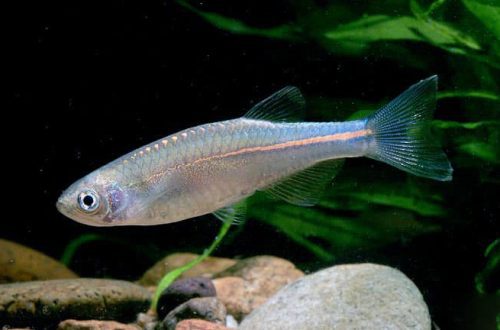
Red Kadango
Red Kadango or Copadichromis Kadango, scientific name Copadichromis borleyi, belongs to the family Cichlidae (Cichlids). Relatively peaceful fish, aggression is manifested only during the spawning period, which makes it possible to keep in a common spacious aquarium with other peaceful species of cichlids living in the same area.

It belongs to the Utaka group, whose representatives live in open water and feed on zooplankton. In nature, they form numerous shoals, numbering hundreds and even thousands of individuals.
Contents
Habitat
An endemic species for Lake Malawi (Nyasa) in East Africa, located on the border of the state of the same name Malawi and neighboring countries. It occurs throughout the lake in open water near the shoreline at a depth of 5–20 meters.
This species was first discovered in the area of the village of Kadango, on the southern coast of the lake, which is reflected in its commercial name.
Brief information:
- The volume of the aquarium – from 300 liters.
- Temperature – 26-28°C
- Value pH — 7.6–8.5
- Water hardness – medium and high hardness (10-25 dGH)
- Substrate type – sandy, rocky
- Lighting – subdued or moderate
- Brackish water – no
- Water movement – light or moderate
- The size of the fish is 15–17 cm.
- Nutrition – any food rich in protein
- Temperament – conditionally peaceful
- Keeping in a harem with one male and several females
Description
Adult individuals reach a length of 15-17 cm, sometimes grow up to 20 cm. The head is large with a large mouth, which allows swallowing large portions of water, with plankton contained in it.
There are several subspecies that live in different parts of the lake, differing in body color. In aquariums, varieties with a blue head and an orange, golden, or red body are common. The latter variety is the most popular in the aquarium hobby. Sometimes three dark dots may be present on the sides of the body.

Females are somewhat smaller than males and are more modestly colored. The color is dominated by gray or silver tones. At a young age of up to 3 weeks, both sexes appear equally gray without bright colors.
Food
In the home aquarium, most foods will be accepted in dry, frozen and live form. The daily diet can consist of flakes, granules with the addition (if possible) of brine shrimp, bloodworms, large daphnia and other small invertebrates.
It’s importantso that the feed contains some amount of plant components for a balanced diet.
Maintenance and care, arrangement of the aquarium
Red Kadango requires considerable space to swim. The minimum volume of the aquarium for a group of 3-4 fish should start at 300 liters. The design uses a sandy substrate, heaps of stones, fragments of rocks. A good addition would be an artificial voluminous background that imitates a rocky coast.
Live plants are not required. If desired, it is permissible to place several species that can grow in an alkaline environment. For example, Vallisneria, some Anubias, Arrowhead styloid, as well as numerous mosses and ferns.
The water of Lake Nyasa has a stable hydrochemical composition with high pH and dGH values. Such conditions must be ensured for long-term maintenance. It is unacceptable to find fish in soft, slightly acidic water.
High water quality is achieved by its weekly renewal by 10–20% of the tank volume with simultaneous cleaning of the soil from organic waste (uneaten food residues, excrement, etc.). The installation of a productive filtration system serves the same purpose. The higher its efficiency, the less maintenance effort will be required from the aquarist. Professional filters will allow you to make the necessary changes to the water much less often without compromising the aquarium’s biosystem. The minimum required set of equipment, in addition to the filter, includes a heating, lighting and aeration system.
Behavior and Compatibility
Relatively peaceful representative of the Malawian cichlids, aggression is manifested only during spawning, so it can be kept with other calm species of comparable size. It is important that the color of neighboring fish is opposite, so that the males of Copadichromis Kadango do not perceive them as rivals.
In small tanks, in this case for 300 liters, it is recommended to form the composition of the group according to the type of harem with a predominance of females.
Breeding / breeding
Fish are easy to breed in a home aquarium. Optimum conditions for spawning are achieved at temperatures of 25–27°C and pH values around 8.0–8.5.
During the mating season, the male chooses a place at the bottom for future masonry. Usually it is located at the base of a large stone. Dig a small hole and clean it of debris. The male then begins the courtship process.
Each female lays up to 60 eggs, which are immediately placed in the mouth – this is a protective evolutionary mechanism that is characteristic of most cichlids of the Nyasa and Tanganyika rift lakes. For fertilization, an equally interesting method is used. Each male on the anal fin has a pattern of bright contrasting dots resembling eggs, which are mistakenly perceived by females as real ones. When she tries to take them, the male releases the seed and fertilization occurs.
During the entire incubation period (3–4 weeks), the eggs are in the female’s mouth. All this time she does not eat and is very vulnerable to the attacks of the neighbors in the aquarium. Experienced aquarists prefer to deposit females in the second or third incubation week in a hotel tank. When the fry become independent, the female returns.
Don’t keep her away from the main group for too long. There is a risk that she will lose her place in the internal hierarchy and be viewed as an outsider by her kindred.
Fish diseases
The main cause of the disease is unsuitable living conditions and poor nutrition, they provoke a disease called Malawi Bloat, which is inherent in many species of fish from the lake of the same name. In favorable conditions, health problems do not arise. Read more about symptoms and treatments in the Aquarium Fish Diseases section.





